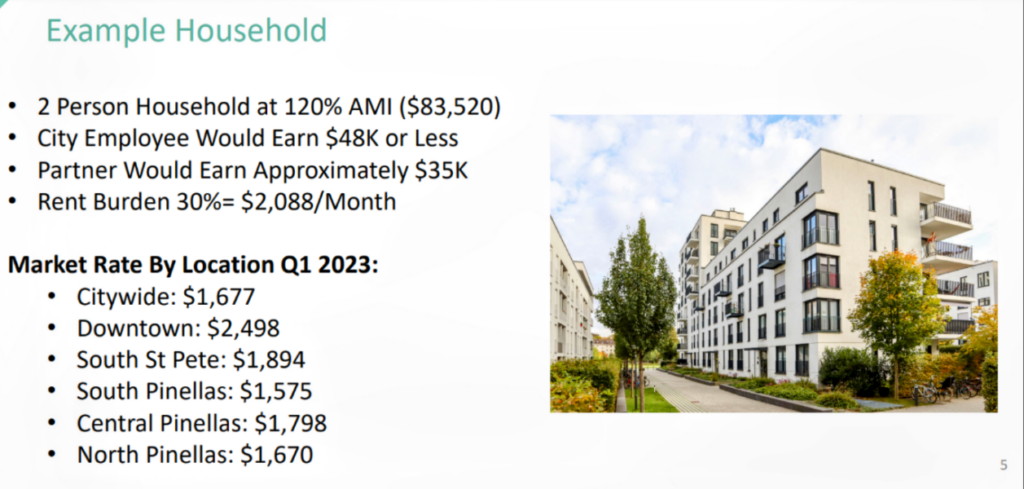Thrive
City rental assistance program off to slow start

An initiative to help 253 St. Petersburg city employees with residency requirements afford soaring rents has just 23 participants through its first eight months.
The program launched in October 2022 with a $1.47 million budget. However, administrators have only committed $168,605 and expended $6,886 in monthly housing bonuses – with some payments as low as $6.60.
At the June 8 Housing, Land Use and Transportation Committee meeting, city officials brainstormed solutions to increase participation. Amy Foster, housing and neighborhood services administrator, noted that over 50 applicants were deemed ineligible due to “doubling up,” or sharing a home with multiple adults without a separate lease.
“It was a significant number, which is why I put that as a possible recommendation,” Foster said. “If you’re living with grandma or auntie or mom or dad, and you are paying rent, would we accept a rental agreement instead of a lease?”
The program is open to city employees working in specific jobs with residency requirements, including sanitation workers, mail clerks and library assistants. Participants must earn less than $48,000 annually, with a total combined household income under 120% of the area median income (AMI).
Additional stipulations include completing three financial literacy classes within eight months and recertifying at eight and 16 months. Eligible employees can receive up to 24 months of assistance.
They must also have a lease, and Foster noted credit issues or criminal history could prevent people from entering a formal contract. Councilmember Richie Floyd said he would like to explore accepting rental agreements.
The U.S. Department of Housing and Urban Development classifies households spending over 30% of their gross income on housing costs as “rent burdened.” Officials designed the program to keep employees under that threshold.
However, it also counts income for anyone in the household over 18. Foster relayed that a 19-year-old stepchild made one employee ineligible for assistance.
Councilmember Brandi Gabbard suggested raising the age limit to 25 to align with health benefit programs. Councilmember Copley Gerdes noted that parents can now include children under 30 on their insurance.
“You always know every time that you start a new program that you’re going to have to tweak it,” Gabbard said. “It’s not going to be perfect the first time you roll it out, and that’s kind of where we are now.”

A graphic showing example criteria for a participating household. Screengrab.
Foster relayed that 33 employees started applications but did not submit them due to a lack of an income gap or owning a home. Some have St. Petersburg mailing addresses but technically live outside city limits.
One participant received a promotion to an ineligible position, and another withdrew due to only receiving $6.60. Although the program provides up to $500 monthly, the average payment is $324.
While Floyd agreed with the 120% AMI cap – $83,520 for a two-person household – he suggested increasing the $48,000 annual income limit. He also noted the “huge delta” between a $1.47 million budget for this year and next and only paying out $168,605 through the first eight months.
“It took $1.47 million for 253 employees,” Foster said. “Any tweak you make could make it for 500 employees, and then we may not have enough. Let us do some research on the parameters that you have set, and we could bring that back next month.”
St. Petersburg’s residency requirements apply to employees in certain positions hired on or after Oct. 1, 1997. The SEIU Florida Public Services Union led the initiative to provide more opportunities for minorities living within the city’s boundaries.
However, soaring rents are now pricing many workers out of the city they serve while impeding recruitment and retention efforts. Council members did not suggest including employees who live outside St. Pete.
“The whole point is that they live in the city,” Gabbard said. “It’s a driver to help people be able to live in our city and be part of our community.
“Making it available to more people in the lower income categories, to me, makes more sense.”
She also noted that some low-income homeowners applied for assistance. Gabbard expects skyrocketing property insurance rates to increase the need for help among that demographic.
Foster said administrators are already discussing how to prepare for that inevitability – although she questioned if that would put someone on a “financial cliff” when the bonuses expire in two years. Gabbard believes that a temporary solution is worth exploring.
Despite some growing pains, she also expressed her pride in the program.
“It’s very different than anything anyone else is doing,” Gabbard added. “And it is making a difference, even if it’s for a very small portion of our employees at this point.”







